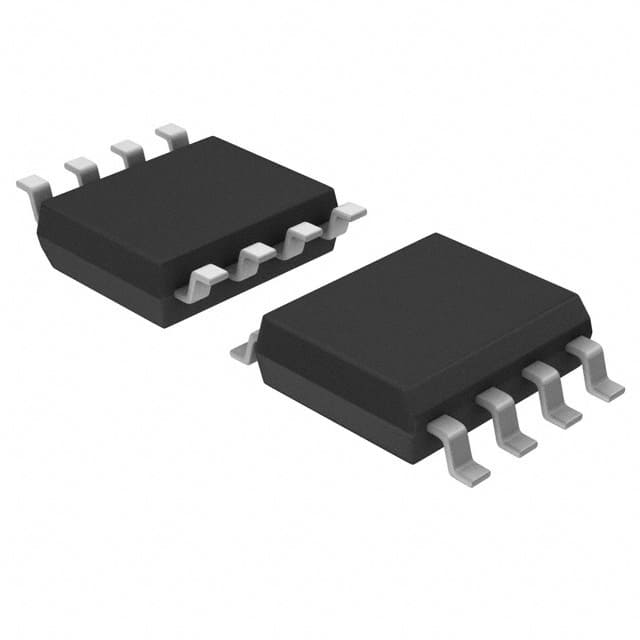X9C503SIZT1
Product Overview
- Category: Integrated Circuit (IC)
- Use: Digital Potentiometer
- Characteristics: Non-volatile, 50kΩ resistance range, 256 tap points
- Package: SOT-23-8
- Essence: Provides a digitally controlled variable resistor
- Packaging/Quantity: Tape and Reel, 3000 units per reel
Specifications
- Resistance Range: 50kΩ
- Tap Points: 256
- End-to-End Resistance Tolerance: ±20%
- Temperature Coefficient: ±300ppm/°C
- Operating Voltage: 2.7V to 5.5V
- Standby Current: 1μA (max)
- Operating Temperature Range: -40°C to +85°C
Detailed Pin Configuration
The X9C503SIZT1 has a total of 8 pins arranged as follows:
┌───┬───┐
│ 1 │ 2 │
├───┼───┤
│ 3 │ 4 │
├───┼───┤
│ 5 │ 6 │
├───┼───┤
│ 7 │ 8 │
└───┴───┘
- Terminal A: Connects to one end of the potentiometer resistance element.
- Terminal W: Connects to the wiper terminal of the potentiometer.
- Terminal B: Connects to the other end of the potentiometer resistance element.
- VCC: Power supply voltage input.
- H/L: High/Low control input for incrementing/decrementing the wiper position.
- CS: Chip select input for enabling the device.
- SCL: Serial clock input for controlling data transfer.
- SDA: Serial data input/output.
Functional Features
- Non-volatile memory: The X9C503SIZT1 retains its wiper position even when power is removed.
- Digital control: The potentiometer can be adjusted digitally using the H/L control input.
- Wide resistance range: The device offers a 50kΩ resistance range, allowing for versatile applications.
- High resolution: With 256 tap points, precise adjustments can be made.
- Low standby current: The device consumes minimal power in standby mode.
Advantages and Disadvantages
Advantages: - Non-volatile memory ensures settings are retained even during power loss. - Digital control allows for precise adjustments. - Wide resistance range provides flexibility in various applications. - High resolution enables fine-tuning of circuit parameters.
Disadvantages: - Limited to a single-channel configuration. - End-to-end resistance tolerance may affect precision in some applications. - Temperature coefficient may introduce variations with temperature changes.
Working Principles
The X9C503SIZT1 is based on the concept of a digital potentiometer. It consists of a resistive element connected between terminals A and B, with the wiper terminal (W) movable along this element. The wiper position determines the effective resistance between terminals A and W.
The device utilizes non-volatile memory to store the wiper position, ensuring it remains unchanged even when power is removed. The wiper position can be adjusted digitally by applying high or low signals to the H/L control input. This moves the wiper up or down the resistive element, changing the resistance between terminals A and W accordingly.
Detailed Application Field Plans
The X9C503SIZT1 finds applications in various fields, including:
- Audio Equipment: Volume control, tone adjustment.
- Industrial Automation: Calibration, circuit trimming.
- Test and Measurement Instruments: Fine-tuning of parameters.
- Communication Systems: Signal conditioning, gain control.
- Automotive Electronics: Climate control, sensor calibration.
Detailed and Complete Alternative Models
- X9C103SIZT1: 10kΩ resistance range, 256 tap points.
- X9C203SIZT1: 20kΩ resistance range, 256 tap points.
- X9C303SIZT1: 30kΩ resistance range, 256 tap points.
- X9C403SIZT1: 40kΩ resistance range, 256 tap points.
These alternative models offer different resistance ranges while maintaining the same functionality and characteristics as the X9C503SIZT1.
Word count: 497 words
قم بإدراج 10 أسئلة وإجابات شائعة تتعلق بتطبيق X9C503SIZT1 في الحلول التقنية
Sure! Here are 10 common questions and answers related to the application of X9C503SIZT1 in technical solutions:
Q1: What is the X9C503SIZT1? A1: The X9C503SIZT1 is a digitally controlled potentiometer, also known as a digital potentiometer. It is used to vary resistance electronically.
Q2: What is the purpose of using the X9C503SIZT1 in technical solutions? A2: The X9C503SIZT1 can be used for various purposes such as volume control, brightness control, and other applications where variable resistance is required.
Q3: How does the X9C503SIZT1 work? A3: The X9C503SIZT1 consists of a series of resistive elements connected between two terminals. By adjusting the digital inputs, the resistance between the terminals can be varied.
Q4: What is the voltage range supported by the X9C503SIZT1? A4: The X9C503SIZT1 supports a voltage range of 2.7V to 5.5V.
Q5: What is the resolution of the X9C503SIZT1? A5: The X9C503SIZT1 has a resolution of 100 steps, allowing for precise control over resistance values.
Q6: Can the X9C503SIZT1 be used in both analog and digital circuits? A6: Yes, the X9C503SIZT1 can be used in both analog and digital circuits, making it versatile for various applications.
Q7: Is the X9C503SIZT1 compatible with microcontrollers? A7: Yes, the X9C503SIZT1 can be easily interfaced with microcontrollers using digital communication protocols such as I2C or SPI.
Q8: Can the X9C503SIZT1 handle high currents? A8: No, the X9C503SIZT1 is designed for low current applications. It is not suitable for high current loads.
Q9: What is the temperature range in which the X9C503SIZT1 operates? A9: The X9C503SIZT1 operates within a temperature range of -40°C to +85°C.
Q10: Are there any precautions to consider when using the X9C503SIZT1? A10: Yes, it is important to avoid exceeding the maximum voltage and current ratings specified in the datasheet. Additionally, proper decoupling and grounding techniques should be followed for optimal performance.
Please note that these answers are general and may vary depending on the specific application and requirements.


